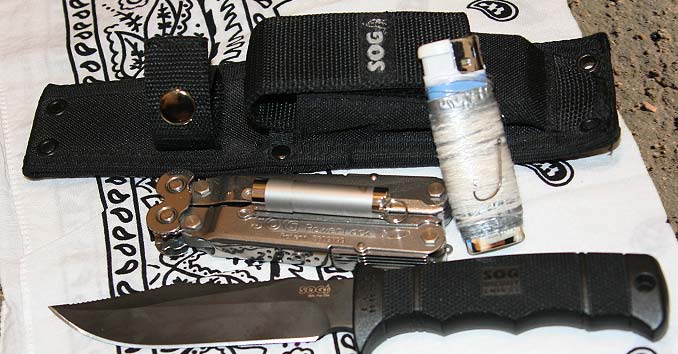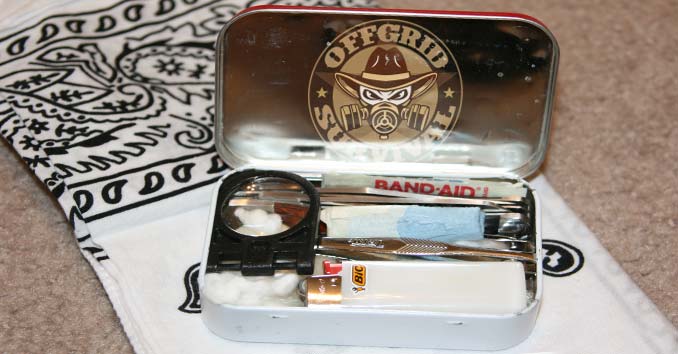
When it comes to emergency preparedness, a well thought out and personally prepared survival kit is probably one of the most important things you can carry. But notice what I said there: I didn’t say a commercial purchased kit, but instead one that you put together yourself. When it comes to buying the perfect emergency kit, that can only be done by personalizing every item in it and tailoring it to your unique preparedness needs.
There is no such thing as a one-size-fits-all survival kit!
What to Carry in Your Kit, and Why you Should Always Carry One
Having a survival kit can sure make life a lot easier during a survival situation. While no kit can ever replace good old fashion knowledge and training, having one is an essential part of the preparedness equation.
Most survivalists recommend having a few different types of kits.
- The first type is called an EDC (Every Day Carry) and is something that you keep with you at all times. It’s usually small enough to fit in your pocket and is filled with only essential survival items.
- The second type is called a Bug Out Bag. A Bug Out Bag takes the EDC concept but amplifies it for long term survival situations. It’s basically a larger version of your EDC but contains more of the items you need to survive after a disaster. A Bug Out Bag is designed to grab at a moment’s notice; they should always be kept somewhere where you can quickly access them during an evacuation.
When selecting gear for your survival kit, you need to consider the types of disasters you’re preparing for and the environments you will encounter when disaster strikes. For instance, the types of items I carry when I’m out backcountry hiking or fishing in the wilderness are entirely different than the gear I pack in my urban survival bags.
When it comes to traditional survival kits, the kind you slip into a pocket, I usually use something like an Altoids tin to carry my gear. It’s inconspicuous, and it helps keep everything in place in my pocket. Here is a look at one of the kits that I carry, and some ideas to get you started:
When selecting a container, try to find something that has more than one use or something that is discreet. For example, you can use:
- A Metal Band-Aid Box
- A Plastic First Aid Case
- Altoids tins
- Ammunition Boxes
- Old Plastic Hiking Bottles
Ideally, your case should be:
- Waterproof, or Water-repellent (or vacuum sealed in air tight plastic)
- Easy to carry
- Durable

The contents of your case will depend on your location and your needs, but here is a list of the basics that I add to my Wilderness Survival Kits.
- Lighter: In a survival situation, don’t be a fool! Remember you’re not trying to be “Mr. Outdoors,” you’re trying to survive! It’s much easier to light a fire with a lighter than it is to mess around with a match or some other fire starting technique.
- Backup Matches: While my first choice is always going to be a simple lighter, I also like to carry backups of essential gear. When selecting a match, I always carry the wooden stick type. I break the stick in half, that way it doesn’t take up as much room in the kit, and then dip them in wax before I place them in the tin. The wax waterproofs the match and protects it from the elements. Tear the striker off from the box, then wrap everything in plastic wrap.
- Small Locking Pocket Knife: Every kit should have a knife.
- String & Wire: ( I recommend fishing line or breaking open a cheap case of floss and taking the whole spool out.)
- Tweezers
- Needle ( Can be used with the floss or fishing string to sew)
- Fishing hooks and a few small weights.
- Tinder (shove cotton into all the loose space in your case, this can be a big help when trying to start a fire.)
- Scalpel Blades
- Finger Nail Clipper
- Flint: Remeber, I like backups especially when it comes to fire.
- Whistle
- Small Signal Mirror
- Laminated Survival Guide: This is something that you should customize, it can contain reminders, emergency contact info or navigation aids.




I might add a few peices of candy, they can tide you over until you can find something to eat. Also, since the brain runs purely on glucose, simple sugars (like the kind candy is made up of), is a fast easy, delicious treat that can also help to calm the mind.
To be more specific, Tootsie rolls will be the best for the cause
Outstanding idea, Josie! I would also add, space permitting, a small candle.
I guess flashlights will be better than candles. What do you think? We may take a spare flashlight too, i.e. 2 flashlights in our bags
Yeah I think flashlight is better because in candles we can consume many matches and candles but in flashlight we just need extra batteries and also the light of the candle is easy to die when a wind occurs..
i was wondering, what would the number of knives in your bug out bag have to be, i was just asking because i currently have 3 or 4 in my bug out bag. 2 of them are small folding knives, another is an axe, the other is a survival knife
I’m surprised that you didn’t include any water purification item in the bug out bag.
I will also recommend a whistle….remember the titanic movie. You may get the reason why I am telling so.
solar
charger for mobile phone could be great help.
I like how you mentioned that a survival kit will always vary depending on the type of disaster that you are preparing for, although there are some things that are indispensables. My husband and I just moved to a new house where the area is quite remote and we want to make sure we´re prepared for anything. I will start looking for a company that sells the product we need for our survival kit.
I am looking for about your product place lace me a message. When I post this, I am looking for more Information on this